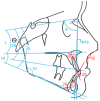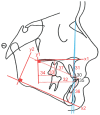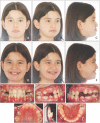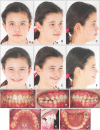Zygomatic miniplates for skeletal anchorage in orthopedic correction of Class III malocclusion: A controlled clinical trial
- PMID: 28337421
- PMCID: PMC5359630
- DOI: 10.4041/kjod.2017.47.2.118
Zygomatic miniplates for skeletal anchorage in orthopedic correction of Class III malocclusion: A controlled clinical trial
Abstract
Objective: To evaluate the effects of facemask therapy, which was anchored from the zygomatic buttresses of the maxilla by using two miniplates, in skeletal Class III patients with maxillary deficiency.
Methods: Eighteen skeletal Class III patients (10 girls and 8 boys; mean age, 11.4 ± 1.28 years) with maxillary deficiency were treated using miniplate-anchored facemasks, and their outcomes were compared with those of a Class III control group (9 girls and 9 boys; mean age, 10.6 ± 1.12 years). Two I-shaped miniplates were placed on the right and left zygomatic buttresses of the maxilla, and a facemask was applied with a 400 g force per side. Intragroup comparisons were made using the Wilcoxon test, and intergroup comparisons were made using the Mann-Whitney U-test (p < 0.05).
Results: In the treatment group, the maxilla moved 3.3 mm forward, the mandible showed posterior rotation by 1.5°, and the lower incisors were retroclined after treatment. These results were significantly different from those in the control group (p < 0.05). No significant anterior rotation of the palatal plane was observed after treatment. Moreover, changes in the sagittal positions of the maxillary incisors and molars were similar between the treatment and control groups.
Conclusions: Skeletally anchored facemask therapy is an effective method for correcting Class III malocclusions, which also minimizes the undesired dental side effects of conventional methods in the maxilla.
Keywords: Class III; Facemask; Miniplate; Skeletal anchorage.
Conflict of interest statement
The authors report no commercial, proprietary, or financial interest in the products or companies described in this article.
Figures








Comment in
-
Reader's Forum.Korean J Orthod. 2017 Nov;47(6):341-343. doi: 10.4041/kjod.2017.47.6.341. Epub 2017 Sep 29. Korean J Orthod. 2017. PMID: 29090121 Free PMC article. No abstract available.
References
-
- Tortop T, Keykubat A, Yuksel S. Facemask therapy with and without expansion. Am J Orthod Dentofacial Orthop. 2007;132:467–474. - PubMed
-
- Gallagher RW, Miranda F, Buschang PH. Maxillary protraction: treatment and posttreatment effects. Am J Orthod Dentofacial Orthop. 1998;113:612–619. - PubMed
-
- Chen L, Chen R, Yang Y, Ji G, Shen G. The effects of maxillary protraction and its long-term stability--a clinical trial in Chinese adolescents. Eur J Orthod. 2012;34:88–95. - PubMed
-
- Cha KS. Skeletal changes of maxillary protraction in patients exhibiting skeletal class III malocclusion: a comparison of three skeletal maturation groups. Angle Orthod. 2003;73:26–35. - PubMed
-
- Kapust AJ, Sinclair PM, Turley PK. Cephalometric effects of face mask/expansion therapy in Class III children: a comparison of three age groups. Am J Orthod Dentofacial Orthop. 1998;113:204–212. - PubMed
LinkOut - more resources
Full Text Sources
Other Literature Sources
